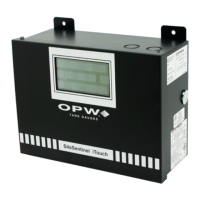Doc. No.: M1500, Rev. 6
Page 8 of 127
• 67733 Gross Point Road 900 Santa Fe Dr.
Introduction
This manual describes the installation procedures for the SiteSentinel® iTouch™ Integrated Monitoring
System. Included in this manual are installation instructions for the Controller, probes and sensors.
1.1 Warnings
1.1.1 Safety
When working in an environment containing fuel and fuel vapors, there is
ALWAYS a risk of fire and explosion.
TO AVOID SEVERE INJURY OR DEATH, KEEP ALL POSSIBLE IGNITION
SOURCES AWAY FROM HAZARDOUS AREAS.
Disconnect power before installing. DO NOT install this equipment in a
volatile, combustible or explosive atmosphere (the “hazardous area” defined
in the National Electrical Code).
Certain components have DANGEROUS voltages even with the power cord
disconnected.
NOTE: Many of the procedures described in the following pages must be followed for each tank that is to be
included in the system. Please read the directions carefully before proceeding.
Improper installation may endanger installers and users of this equipment! Read these instructions
CAREFULLY.
Installers must know the requirements of intrinsically safe devices, and must strictly obey instructions in this
manual to perform a safe installation.
1.1.2 Compliance
Installation must comply with the National Electrical Code (NFPA No. 70) and the Automotive and Marine
Service Station Code (NFPA No. 30A).
Follow all of your local or regional codes as well.
A fuel tank is a hazardous area as defined in the NEC. Do not mount any part of
the system, or any external devices (other than probes or sensors) within or above
the hazardous area.
1.1.3 Precision Leak Test
A precision leak test should be performed on each tank – especially older ones – before installing the
SiteSentinel iTouch. This test makes sure that leak data generated by the system is accurate and reliable. A
pressurized precision leak test can be done on a tank after the probe has been installed, but DO NOT let the
pressure exceed 20 psi.

